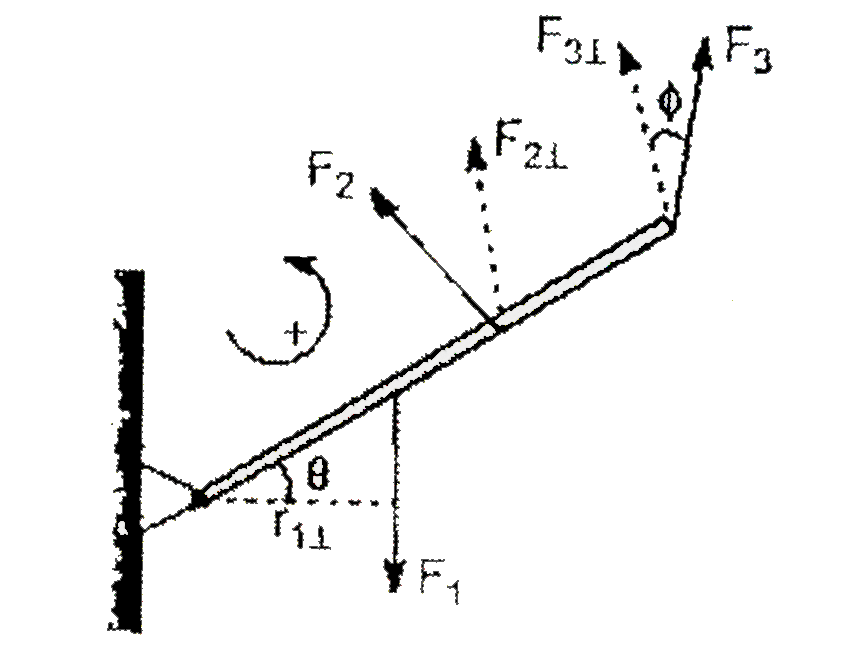A moving particle is acted upon by several forces F1,F2,F3….etc. One of the force is chosen sat F2 the which of the following statement about F2 will be true.
Work done by F2 will be negative if speed of the particle decreases
Work done by F2 will be positive if speed of the particle increases
Work done by F2 will be equal to the work done by other forces if speed of the particle does not change
If F2 is a conservative force, then work done by all other forces will be equal to change in potential energy due to force F2 when speed remains constant.
The correct Answer is:D
By work energy theorem
WF2+Wother=ΔK
⇒WF2=ΔK−Wother
So A & B are wrong
If speed do not change ΔK=0
then WF2=−Wother...(1)
So WF2≠Wother
If F2 is conservative force then
ΔU=−WF2=Wother(from(1)
Topper's Solved these Questions
- DAILY PRACTICE PROBLEMBOOK - RESONANCECHAPTER - DAILY PRACTICE PROBLEMEXERCISE - DPP No.30
9 Videos
- DAILY PRACTICE PROBLEMBOOK - RESONANCECHAPTER - DAILY PRACTICE PROBLEMEXERCISE - DPP No.31
20 Videos
- DAILY PRACTICE PROBLEMBOOK - RESONANCECHAPTER - DAILY PRACTICE PROBLEMEXERCISE - DPP No.28
9 Videos
- CURRENT ELECTRICITYBOOK - RESONANCECHAPTER - CURRENT ELECTRICITYEXERCISE - High Level Problems (HIP)
21 Videos
- ELECTRO MAGNETIC WAVESBOOK - RESONANCECHAPTER - ELECTRO MAGNETIC WAVESEXERCISE - Exercise 3
27 Videos
Similar Questions
Fig shows three forces F1,F2 and F3 acting on a rod pivoted at its end. Find the torque of each force about pivot.

View SolutionA homogeneous rod of length L is acted upon by two forces F1andF2 applied to its ends and directed opposite to each other. With what force F will the rod be stretched at the cross section at a distance l from the end where F1 is applied?
View Solution
Knowledge Check
Which of the following statements is true for IO2F−2?
AThe electrons are located at the corners of a trigonal bipyramidal but one of the equatorial pairs is unshared.BIf has sp3d hybridisation and is T-shaped.CIts structure is analogous to SF4.D(a) and (c) bothA particle of mass m is acted upon by a force F=t2−kx . Initially , the particle is at rest at the origin. Then
Aits displacement will be in simple harmonicBits velocity will be in simple harmonicCits acceleration will be in simple harmonicDNone of the aboveFigure shown a wooden block at rest in equilibrium on a rought horizontal plane being acted upon by force F1=10N,F2=2N, as shown .IFF1 is removed , the resulting force acting on the block will be
 A2N toward leftB2N toward rightC0NDcannot be determined
A2N toward leftB2N toward rightC0NDcannot be determined
A uniform rod of mass m and length is acted upon by the forces F1 and F2 Find that:
a. linear-and angular acceleration of the rod.
b. value of x for which the point P does not accelerate.

View SolutionA particle is acted upon by a force which varies with position x as shown. F is in N and x is in m F 10 5 X 2 -10
View SolutionLet f(x) be linear functions with the properties that f(1)≤f(2),f(3)≥f(4) and f(5)=5. Which one of the following statements is true?
View SolutionA particle is observed from two frames S1andS2. The frame S2 moves with respect to S1 with an acceleration a. Let F1andF2 be the pseudo forces on the particle when seen from S1andS2 respectively. Which of the following are not possible ?
View SolutionA moving perticle of mass m is acted upon by five forces →F1,→F2,→F3,→F4 and →F5. Forces →F2 and →F3 are conservative and their potential energy funcations are U and W respectively. Speed of the particle changes from Va to Vb when it moves from position a to b. Choose the correct option :
View Solution
